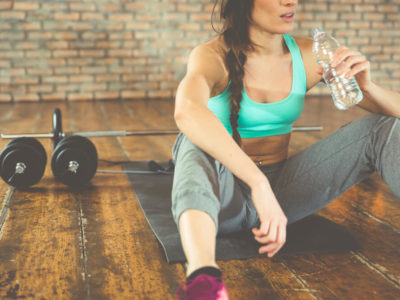Table of Contents[Hide][Show]
Is the winter weather interfering with your fitness goals?
It’s tempting to stay indoors—and warm—when the days are cold and the night falls early.
But if you find yourself hitting the snooze button on chilly mornings and choosing hot chocolate over hot yoga, it’s time to shake up your fitness routine.
Instead of avoiding the cold weather, use it to your advantage with heart-pumping, calorie-burning winter exercises.
These are our favorite outdoor activities that’ll keep you fit, happy, and healthy during the winter months.
Cross-Country Skiing
Skiing is one of the most iconic winter activities, but what do you do if you aren’t near mountains? That’s where cross-country skiing comes in.
Originally designed as a mode of winter transportation, cross-country skiing is a heart-pumping blend of downhill skiing, snowshoeing, and hiking.
Outfitted with just skis and poles, you’ll hit the trails instead of the slopes, and cross the snowy terrain.
Sounds easy? It is… but it’s also exhausting! Similar to walking, cross-country skiing is a full-body exercise that uses almost all of the major muscles in your body, including your quadriceps, hamstrings, glutes, calves, chest, back, biceps, triceps, and core.
Add to that, cross-country skiing is nonstop exercise unlike sledding, which allows you to sit on the way down, or downhill skiing, which gives you a break while you’re on the ski lift.
One hour of cross-country skiing can burn roughly 490 calories.
And the simplicity of cross-country allows room for you to make it even more of a calorie burner. Try adding additional resistance, such as a weighted vest. Or incorporate short bursts of speed, similar to adding sprints to a long run, for more of a HIIT-style workout.
Downhill Skiing
What feels better than the sun on your face on a cold wintery day? Burning calories at the same time, of course! And downhill skiing is one of the best ways to achieve both.
Downhill skiing incorporates elements of both cardiovascular exercise (aerobic exercise) and strength training (anaerobic exercise) for one of the winter season’s most effective workouts.
Research shows that the cardiovascular benefits of skiing are similar to those of rowing or indoor cycling. At the same time, the swift turns, jumps, and other movements used for skiing fire up your lower body, while your core keeps you balanced and stabilized.
Downhill skiing is also a form of interval training. After an intense, muscle-pushing race to the bottom, you get to take a breather and enjoy the views on the lift back to the top.
Although the actual calories burned will be affected by the terrain, your speed, and your skill level, you’ll burn about 430 calories per hour.
Keep in mind, though, that this only accounts for the time you’re skiing, not the time you’re riding uphill on a ski lift.
Related
Fitness Boost: The Best Strengthening Exercises
Check out our top strengthening exercises for the lower body, upper body, core, and back, plus 5 tips for making the most of your workout.
Ice Skating
Ice hockey… figure skating… speed skating… If you’ve ever watched the Winter Olympics, you already know that ice skating is a serious sport.
And even though it’s a far cry from the Olympics to your local rink, your muscles will surely feel sore the next day!
Despite the ease with which skaters appear to glide across the ice, skating is the winter exercise equivalent of running. It works your abdominal muscles and lower body, including your glutes, quadriceps, hamstrings, and calves.
Along with strengthening your muscles, ice skating is also a great cardio workout. Even if you’re just starting out, you’ll get your heart pumping with just a few laps around the rink.
On average, you can expect to burn over 500 calories per hour when you’re ice skating. You can bump that up by increasing your speed, or, once you’ve gotten more comfortable on the ice, adding in spins, jumps, or other fun moves.
Sledding
Burning calories while you’re racing down a hill? Maybe not. But sledding isn’t just about going down; first, you have to go up.
Carrying your sled up a snow-covered hill can be quite the workout, with each run starting off with an uphill climb. In fact, you can think of sledding as an outdoor stair climber!
But sledding also uses a surprising number of muscles. You’ll mostly focus on your lower body as you power up the hill, especially your glutes, quadriceps, hamstrings, and calves. You’ll also activate the muscles of your upper body to help you carry or haul the sled.
On your way downhill, you’ll engage your core to keep balanced, and if you steer your sled, you’ll engage your entire upper body, including your arms, shoulders, and back muscles.
The number of calories you burn while sledding can vary greatly. Some of the factors that can influence your calorie burn include how high you climb, how steep the hill is, the depth of the snow, and the weight of your sled.
On average, however, you’ll burn close to 500 calories per hour while you’re sledding.
Snowboarding
Miss your summer surfing? Then it’s time to pick up a different kind of board—a snowboard.
Despite its popular appeal with winter sports enthusiasts, snowboarding can be an exhausting sport, working almost every muscle in your lower body and getting your heart rate up.
A thrilling, adrenaline-inducing snowboarding session will constantly, consistently engage your abs. Whether you’re using them to twist, turn, or just stay balanced and upright, your entire core will be engaged—like crunches or planks, but even more fun!
Snowboarding is also an amazing lower-body workout. Your glutes, quadriceps, hamstrings, and calves will work hard to get you going and keep you going.
A one-hour snowboarding session will burn about 350 calories. But as with skiing, this only includes the time that you’re actually riding your snowboard and not the time you spend going back up on the lift.
Snowshoeing
If you’ve never tried snowshoeing, you might think that going for a walk would be a nice, relaxing activity. But try it once and you’ll quickly realize that snowshoeing is an incredible workout.
The main focus will be on your lower body, especially your glutes, quadriceps, and hamstrings. But with the unsteadiness of the terrain, your core will also get an intense workout just to keep you balanced.
To turn snowshoeing into a full-body activity, you can use poles. This will incorporate your upper body muscles, including your triceps, biceps, shoulders, chest, and more.
Although your body movements when you snowshoe are similar to those when you go for a walk, you’ll burn more calories than walking or even running. Not only is your body burning more calories to keep you warm, but you also increase the exercise intensity by lifting your legs higher to get your feet out of the snow.
Of all the winter exercises on our list, snowshoeing is the biggest calorie burner. An hour of snowshoeing burns a whopping 575 calories per hour!
Have Fun!
Although these winter activities are true exercises, there are plenty of other fun things you can do in the winter to burn calories.
Here are a few of our favorites.
- Have a snowball fight
- Build a snowman
- Go ice fishing
- Climb over snow drifts
- Ride a snowmobile
As long as you’re outdoors and getting your heart rate up, your possibilities are endless!
Related
Maximizing Muscle Recovery: 14 Proven Strategies
Discover the best muscle recovery techniques to repair and restore your muscles after your workouts to keep them healthy and strong.
How to Maximize Your Winter Workouts
Ready to take your fitness outdoors for the winter?
Before you start, here are a few things to keep in mind.
- Take it easy when you first start. Some of these winter activities might activate little-used muscles; take rest days in between.
- If you’re new to winter exercises, consider taking lessons for activities such as skiing and snowboarding.
- Dress appropriately, with layers to keep you warm. Make sure you have all the necessary gear.
- Take a probiotic supplement. Our favorite probiotic from Just Thrive helps balance your gut microbiome to give you energy, strengthen your immune system, and promote your overall health so you can focus on fitness. Best of all, it’s guaranteed to arrive 100% alive in your gut and has 1000x better survivability vs. leading probiotics.
- Stay hydrated. While you might not get as hot as you would on a summer’s day, these winter activities will still make you sweat.
- Get plenty of sleep. These winter activities burn a lot of calories, so you’ll want to be well-rested before you hit the slopes, trails, rink, etc.
Final Thoughts
These fun winter activities are an excellent way to burn calories and stay fit while enjoying the crisp winter air.
You may be tempted to stay indoors and warm, but invigorating exercise, fresh air, and a dose of sunshine will do wonders for your body, mind, and mood.
Fitness is achievable in every season, including winter, so get out there and have some fun!
You May Also Like…






